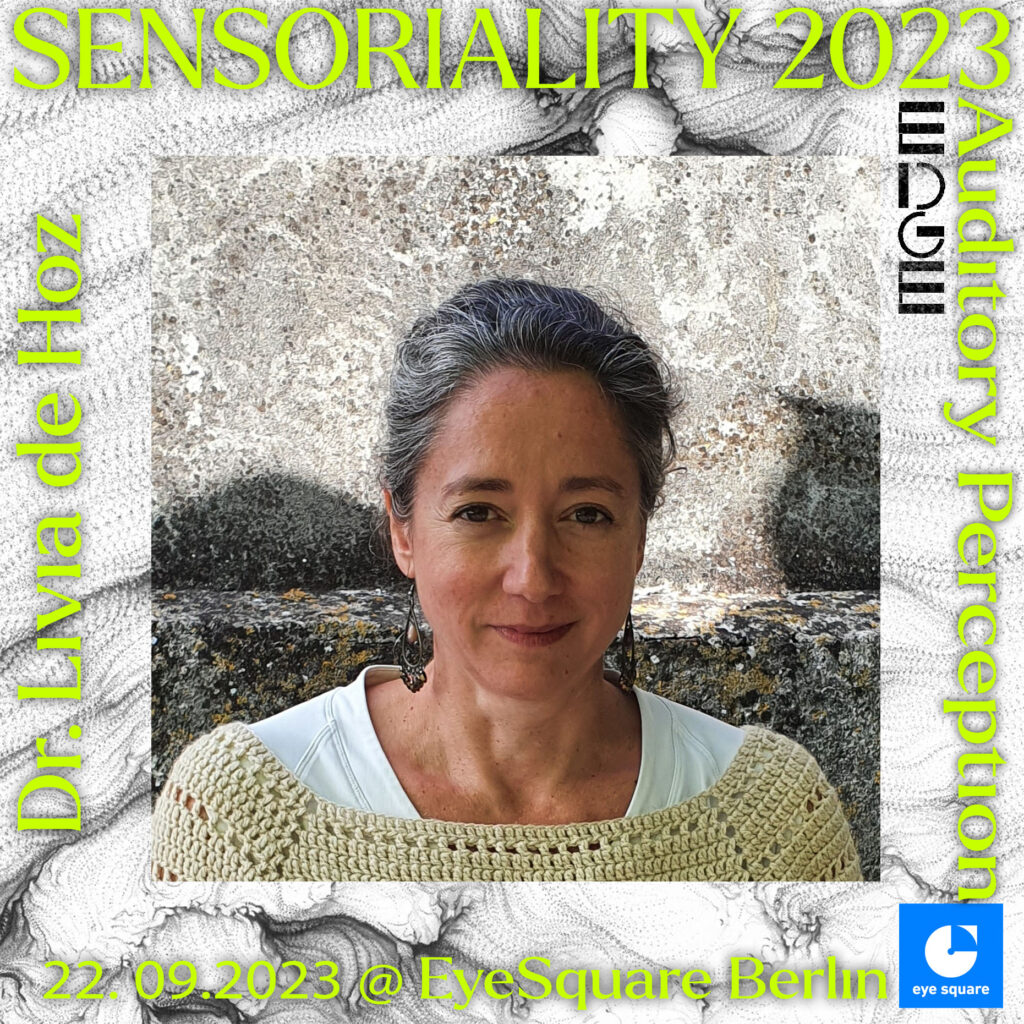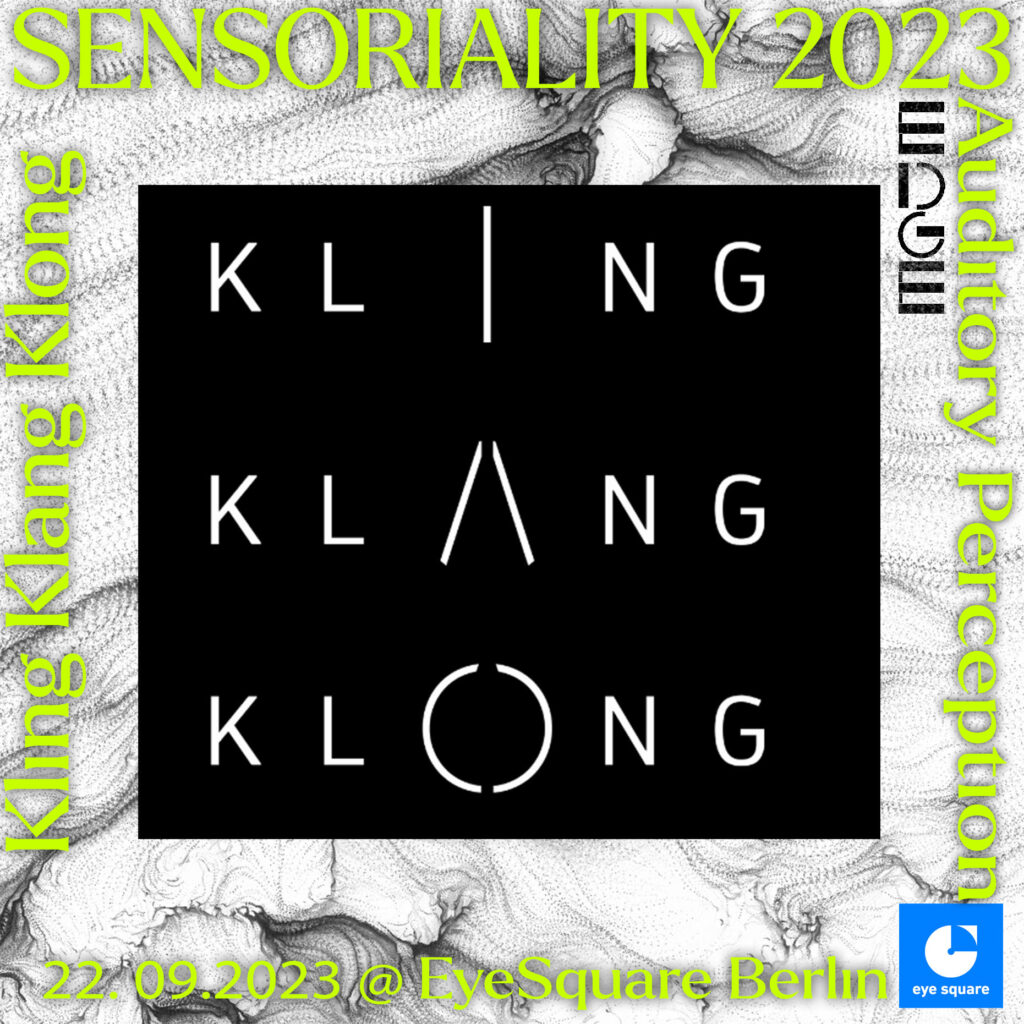Unlock the Secrets of Auditory Perception in our Upcoming Session of Sensoriality: Art and Neuroscience through our Senses!
Date: Friday, September 22nd 2023
Time: 18:30-21:30
Location: Kunsthalle Eye Square, Berlin
Maximum Number of Participants: 25
Description
Are you ready to delve into the mesmerizing world of sound and its profound impact on our perception? You’re invited to a unique workshop that delves into Auditory Perception, bridging art and neuroscience with esteemed guests Kling Klang Klong, Julius Holtz, and Dr. Livia de Hoz. Join us for an extraordinary experience that bridges the gap between art and neuroscience, led by experts in the field!
Auditory perception is more than just hearing – it’s the intricate process through which our brains decipher and make sense of sound waves. Our ears act as gateways, receiving sound information that is then transformed into electrical signals and transmitted to the brain. This workshop will unveil the intricacies of this process, revealing how our minds decode the source, location, frequency, and intensity of sounds, ultimately crafting our conscious perception.

🎶🎨 Immerse Yourself in the Essence of Sound 🎨🎶
Resonance, rhythm, melody, harmony, pitch, and timbre – these are not just words; they are the building blocks of auditory information that shape our sonic experiences. Our workshop’s experts will guide you through the enchanting world of sound, shedding light on each of these elements and their role in shaping our perception.
🔬🌟 The Art and Science of Auditory Perception 🌟🔬
This workshop goes beyond the surface, taking you on a deep dive into the physiology of auditory perception. Understand the intricate mechanisms that allow us to appreciate music, distinguish speech, and develop spatial awareness. Gain insights into the connection between auditory perception and artistic expression – discover how sound can be a powerful tool for creative expression, influencing everything from emotional responses to artistic endeavors.
🌍🎨 Shaping Identity Through Sound 🎨🌍
Just as artists explore themes of human nature, identity, and culture, our workshop unearths the profound impact of auditory perception on shaping who we are. Join us for an unforgettable session that bridges the gap between artistry and neuroscience, where you’ll embark on an artistic and scientific odyssey that will forever change how you perceive the world of sound.
Guests
Your hosts, Eliana Araque and Anna Kanitz have invited Livia de Hoz to speak about her field of research, auditory neuroscience. Kling, Klang, Klong and Julius Holtz will lead the audience through their artistic references.
Agenda
- 18:30 Welcome Participants and Housekeeping
- 18:40 Introduction + Speed Meeting. Presenting EDGE Neuroscience & Art e.V., our hosts Eye Square, the workshop series, session and esteemed guests. Introduction round for attendees with a special focus on auditory preferences.
- 19:20 Activity 1. Embodied practice + Sensory exploration
- 19:30 Neuroscientific talk + Q&A Dr. Livia de Hoz
- 20:00 Embodied practice Audio resonance
—Break—
- 20:20 Activity 2. Embodied practice + Sensory Exploration
- 20:25 Artistic References Kling, Klang, Klong, and Julius Holtz
- 20:55 Activity 3. Embodied practice + Sensory Exploration
- 21:00-end Collective Artistic Practices and Networking
Speakers
Neuroscience

Livia de Hoz, Charité – Universitätsmedizin Berlin
Our brains have evolved to interpret the surrounding environment, a complex amalgam of a myriad auditory, visual, or olfactory stimuli. These stimuli are combined in patterns that are continuously changing but are often predictable. In the auditory domain, each room has echoes that inform us about the size and use of the room, each person speaks with an intonation that informs us about its emotional state, and a moving car makes sounds indicative of its speed and proximity. Learning these patterns allows us to blend out background sounds, interpret noisy foreground signals, or escape an approaching danger. In my lab, we study how peripheral subcortical, and cortical auditory structures interact with each other to hear, listen to, and interpret the soundscape.
During my presentation, which will be aimed for the general public, I will give an overview of the anatomy of the auditory system, from the cochlea to the cortex. I will go over some of the key roles of the auditory system and will relate these to the nature of our soundscape. These roles will serve to highlight some general brain principles as well as principles that are specific to the auditory modality. Finally, we will hear complex sounds that will help Illustrate the extremely complex processing that our auditory system does so seamlessly on a moment-to-moment basis.
Art

Kling Klang Klong
We are a creative studio composing sound and code for sonic experiences.
As a high-performance team, we consist of composers, sound designers, creative thinkers, scientists and technologists. What connects our different expertise is the passion we share for exploring new ways to move people through the impact of sound.
Our work can be found internationally in real and virtual environments, art spaces, museums or events.
Julius Holtz
Julius Holtz’s work explores cross-genre interfaces between technology, acoustic, and electronic music. He is a founding member of sonicfiction.io
Holtz looks at different modes of auditive perception and related cognitive processes. Multisensory music, he investigates by introducing interaction between the audience, visuals, spatial sound environments, and musical form. With sound as their focus, this practice has led to the creation of new interdisciplinary formats. Born in 1982 in Bremen, he studied composition and acoustic communication in Berlin.

Julius Holtz is a lecturer at the Sonic Thinking program of the Hasso Plattner Institut in Potsdam. He has received funding and scholarships from the Senate of Berlin, Musikfonds, INM Berlin, and the Goethe-Institut.
He performed and exhibited his work at prestigious festivals and institutions. These include Wet Sounds Festival in London, Festival of Future Nows in Berlin, Centro de Cultura Digital in Mexico City, Steirischer Herbst in Graz, Ultima Festival in Oslo, Martin-Gropius-Bau in Berlin, Goethe-Institut in Hanoi and the Smithsonian Institution in Washington D.C.
